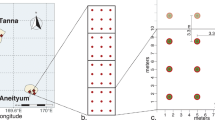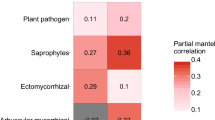Abstract
Gradient analysis is rarely used in studies of fungal communities. Data on macromycetes from eight sites along an elevation gradient in central Veracruz, Mexico, were used to demonstrate methods for gradient analysis that can be applied to studies of communities of fungi. Selected sites from 100 to 3,500 m altitude represent tropical dry forest, tropical montane cloud forest, conifer forest, and their ecotones. From May to October 2010, macromycetes were collected monthly within ten 10 × 10 m permanent plots per site. In total, 672 individuals of 213 species of macromycetes were recorded. Models for richness and diversity for all macromycete and ectomycorrhizal communities displayed peaks in the mid-part of the gradient, and a tendency to increase with elevation, whereas xylophagous fungi displayed a peak in the mid-lower part but tended to decrease with elevation. Cluster and Maximum Likelihood analyses distinguished four communities for both macromycetes and trees, but plant and fungal communities were only partly concordant. Canonical correspondence analysis indicated that macromycete distribution along the gradient is related to slope, relative humidity, soil temperature, soil water content, canopy openness, and litter depth. Spearman’s correlation and regression trees suggested that air and soil temperature, relative humidity, soil water content, canopy openness, vegetation structure and tree species richness were most strongly related to macrofungal functional groups, but these environmental variables were often correlated to the forest type and may not be causal. Variation in the environment along the elevation gradient differentially affected macromycete functional groups. Results from the different methods used in this work were concordant and showed significant patterns.






Similar content being viewed by others
Abbreviations
- AIC:
-
Akaike information criterion
- CCA:
-
Canonical correspondence analysis
- CF:
-
Conifer forest
- ECM:
-
Ectomycorrhizal fungi
- H ′ :
-
Shannon diversity index
- ML:
-
Maximum likelihood
- Sobs:
-
Species richness observed
- TDF:
-
Tropical dry forest
- TMCF:
-
Tropical montane cloud forest
References
Alfredsen G, Høiland K (2001) Succession of terrestrial macrofungi along a deglaciation gradient at Glacier Blåisen, South Norway. Nord J Bot 21:19–37
Balmford A, Lyon AJE, Lang RM (2000) Testing the higher-taxon approach to conservation planning in a megadiverse group: the macrofungi. Biol Conserv 93:209–217
Bertrand Y, Pteijel F, Rouse GW (2006) Taxonomic surrogacy in biodiversity assessments, and the meaning of Linnaean ranks. Syst Biodivers 4:149–159
Bonet JA, Fischer CR, Colinas C (2004) The relationship between forest age and aspect on the production of sporocarps of ectomycorrhizal fungi in Pinus sylvestris forests of the central Pyrenees. For Ecol Manage 203:157–175
Braga-Neto R, Luizao RCC, Magnusson WE, Zuquim G, Castilho CV (2008) Leaf litter fungi in a Central Amazonian forest: the influence of rainfall, soil and topography on the distribution of fruiting bodies. Biodivers Conserv 17:2701–2712
Brehm G, Colwell RK, Kluge J (2007) The role of environment and mid-domain effect on moth species richness along a tropical elevational gradient. Global Ecol Biogeogr 16:205–219
Breiman L (2001) Random forests. Mach Learn 45:5–32
Brown N, Bhagwat S, Watkinson S (2006) Macrofungal diversity in fragmented and disturbed forests of the Western Ghats of India. J Appl Ecol 43:11–17
Burnham KP, Anderson DR (2002) Model selection and multimodel inference: a practical information-theoretic approach, 2nd edn. Springer, New York
Cavender-Bares J, Izzo AD, Robinson R, Lovelock CE (2009) Changes in ectomycorrhizal community structure on two containerized oak hosts across an experimental hydrologic gradient. Mycorrhiza 19:133–142
Chao A, Chazdon RL, Colwell RK, Shen T (2005) A new statistical approach for assessing similarity of species composition with incidence and abundance data. Ecol Lett 8:148–159
Colwell RK (2006) Estimates: statistical estimation of species richness and shared species from samples. Version 8.0.0. User’s guide and application published at: http://purl.oclc.org/estimates
Colwell RK, Rahbek C, Gotelli NJ (2004) The mid-domain effect and species richness patterns: what have we learned so far? Am Nat 163:E1–E23
Condit R, Pitman N, Leigh EG Jr, Chave J, Terborgh J, Foster RB, Núnez V, Aguilar S, Valencia R, Villa G, Mueller-Landau HC, Losos E, Hubbell SP (2002) Beta-diversity in tropical forest trees. Science 295:666–669
De’Ath G, Fabricius K (2000) Classification and regresion trees: a powerful yet simple technique for ecological data analysis. Ecology 81:3192–3198
Durall DM, Gamiet A, Simard SW, Kudrna L, Sakakibara SM (2006) Effects of clearcut logging and tree species composition on the diversity and community composition of epigeous fruit bodies formed by ectomycorrhizal fungi. Can J Bot 84:966–980
Edwards IP, Zak DR (2010) Phylogenetic similarity and structure of Agaricomycotina communities across a forested landscape. Mol Ecol 19:1469–1482
Ferris R, Peace AJ, Newton AC (2000) Macrofungal communities of lowland Scots pine (Pinus sylvestris) and Norway spruce (Picea abies) plantations in England: relationships with site factors and stand structure. For Ecol Manage 131:255–267
Gabel AC, Gabel ML (2007) Comparison of diversity of macrofungi and vascular plants at seven sites in the Black Hills of South Dakota. Am Midl Nat 157:258–296
Gates GM, Mohammed C, Wardlaw T, Ratkowsky DA, Davidson NJ (2011a) The ecology and diversity of wood-inhabiting macrofungi in a native Eucalyptus obliqua forest of southern Tasmania, Australia. Fungal Ecol 4:56–67
Gates GM, Mohammed C, Wardlaw T, Davidson NJ, Ratkowsky DA (2011b) Diversity and phenology of the macrofungal assemblages supported by litter in a tall, wet Eucalyptus obliqua forest in southern Tasmania, Australia. Fungal Ecol 4:68–75
Gates GM, Mohammed C, Ratkowsky DA, Wardlaw T, Davidson NJ (2011c) Diversity and ecology of epigeous ectomycorrhizal fungal assemblages in a native wet eucalypt forest in Tasmania, Australia. Fungal Ecol 4:290–298
Gilbert L (2010) Altitudinal patterns of tick and host abundance: a potential role for climate change in regulating tick-borne diseases? Oecologia 162:217–225
Gilbert GS, Reynolds DR, Bethancourt A (2007) The patchiness of epifoliar fungi in tropical forests: host range, host abundance, and environment. Ecology 88:575–581
Gómez-Hernández M, Williams-Linera G (2011) Diversity of macromycetes determined by tree species, vegetation structure, and microenvironment in tropical cloud forests in Veracruz, Mexico. Botany 89:203–216
Guzmán G, Ramírez-Guillén F, Munguía P (2003) Introduction to the mycobiota of the State of Veracruz (Mexico). Bol Soc Mic Madrid 27:223–229
Heilmann-Clausen J (2001) A gradient analysis of communities of macrofungi and slime moulds on decaying beech logs. Mycol Res 105:575–596
Heilmann-Clausen J, Christensen M (2003) Fungal diversity on decaying beech logs-implications for sustainable forestry. Biodivers Conserv 12:953–973
Heilmann-Clausen J, Aude E, Christensen M (2005) Cryptogam communities on decaying deciduous wood–does tree species diversity matter? Biodivers Conserv 14:2061–2078
Henkel TW, Terborgh J, Vilgalys RJ (2002) Ectomycorhizal fungi and their leguminous hosts in the Pakaraima Mountains of Guyana. Mycol Res 106:515–531
Karp DS, Guevara R (2011) Conversational noise reduction as a win–win for ecotourists and rain forest birds in Peru. Biotropica 43:122–130
Leibold MA, Mikkelson GM (2002) Coherence, species turnover and boundary clumping: elements of meta-community structure. Oikos 97:237–250
Leski T, Aučina A, Skridaila A, Pietras M, Riepšas E, Rudawska M (2010) Ectomycorrhizal community structure of different genotypes of Scots pine under forest nursery conditions. Mycorrhiza 20:473–481
Lodge DJ, Chapela I, Samuels G, Uecker FA, Desjardin D, Horak E, Miller OK Jr., Hennbert GL, Decock CA, Ammirati J, Burdsall HH Jr., Kirk PM, Minter DW, Halling R, Laessøe T, Mueller G, Oberwinkler G, Pegler DN, Spooner B, Petersen RH, Rogers JD, Ryvarden L, Watling R, Turnbull E, Whalley AJS (1995) A survey of patterns in fungal diversity. In: Scheldegger C, Wolseley P (eds) Lichen conservation. Proceedings of the Symposium Lichens—a strategy for conservation. Vancouver, 1994. Mitteilungen der Eidgenossischen Forschungsanstalt fur Wald, Schnee und Landschaft 70: 157–173
Magurran AE (2004) Measuring biological diversity. Blackwell, London
Mandelik Y, Dayan T, Chikatunov V, Kravchenko V (2007) Reliability of a higher-taxon approach to richness, rarity, and composition assessments at the local scale. Conserv Biol 21:1506–1515
McCune B, Grace JB (2002) Analysis of ecological communities, 2nd edn. MJM Software, Gleneden Beach
McCune B, Mefford MJ (1999) PC-ORD. Multivariate analysis of ecological data. Version 4.34. MJM Software, Gleneden Beach
McMullan-Fisher SJM, Kirpatrick JB, May TW, Pharo EJ (2010) Surrogates for macrofungi and mosses in reservation planning. Conserv Biol 24:730–736
Nantel P, Neumann P (1992) Ecology of ectomycorrhizal-basidiomycete communities on a local vegetation gradient. Ecology 73:99–117
Nogués-Bravo D, Araújo MB, Romdal T, Rahbek C (2008) Scale effects and human impact on the elevational species richness gradients. Nature 453:216–220
Nor S (2001) Elevational diversity patterns of small mammals on Mount Kinabalu, Sabah, Malaysia. Global Ecol Biogeogr 10:41–62
O’Dell TE, Ammirati JF, Schreiner EG (1999) Species richness and abundance of ectomycorrhizal basidiomycete sporocarps on a moisture gradient in the Tsuga heterophylla zone. Can J Bot 77:1699–1711
O’Hara RB, Arjas E, Toivonen H, Hanski I (2002) Bayesian analysis of metapopulation data. Ecology 83:2408–2415
Osono T (2007) Ecology of ligninolytic fungi associated with leaf litter decomposition. Ecol Res 22:955–974
Pouska V, Svoboda M, Lepšová A (2010) The diversity of wood-decaying fungi in relation to changing site conditions in an old-growth mountain spruce forest, Central Europe. Eur J For Res 129:219–231
Queenborough SA, Mazer SJ, Vamosi SM, Garwood NC, Valencia R, Freckleton RP (2009) Seed mass, abundance and breeding system among tropical forest species: do dioecious species exhibit compensatory reproduction or abundances? J Ecol 97:555–566
R (2008) R, A language and environment for statistical computing. R Foundation for Statistical Computing, Vienna, URL http://purl.oclc.org/estimates
Rahbek C (1995) The elevational gradient of species richness: a uniform pattern? Ecography 18:200–205
Rossman A (1994) A strategy for an all-taxa inventory of fungal biodiversity. In: Peng CI, Chou CH (eds) Biodiversity and terrestrial ecosystems. Academia Sinica Monograph Series no. 14, Taipei
Rubino DL, McCarthy BC (2003) Composition and ecology of macrofungal and myxomycete communities on oak woody debris in a mixed-oak forest of Ohio. Can J For Res 33:2151–2163
SAS (1997) JMP, version 3.2.2. SAS Institute Inc., Cary
Schmit JP, Lodge DJ (2005) Classical methods and modern analysis for studying fungal diversity. In: Dighton J, White J, Oudemans P (eds) The fungal community, 3rd edn. CRC Press, Boca Raton, pp 193–214
Straatsma G, Krisai-Greilhuber I (2003) Assemblage structure, species richness, abundance and distribution of fungal fruit bodies in a seven year plot-based survey near Vienna. Mycol Res 107:632–640
Sysouphanthong P, Thongkantha S, Zhao R, Soytong K, Hyde KD (2010) Mushroom diversity in sustainable tea forest and the effect of fire damage. Biodivers Conserv 19:1401–1415
ter Braak CJF, Smilauer P (1998) CANOCO reference manual and user’s guide to Canoco for Windows. Centre of Biometry, Wageningen
Torres J, González G (2005) Wood decomposition of Cyrilla raceimiflora (Cyrillaceae) in Puerto Rican dry and wet forests: a 13-year case study. Biotropica 37:452–456
Whittaker RH (1972) Evolution and measurement of species diversity. Taxon 21:213–251
Willig MR, Presley SJ, Bloch CP, Castro-Arellano I, Cisneros LM, Higgins CL, Klingbeil BT (2011) Tropical metacommunities and elevational gradients: effects of forest type from other elevational factors. Oikos. doi:10.1111/j.1600-0706.2011.19218.x. Accessed 18 Mar 2011
Wilson MV, Shmida A (1984) Measuring beta diversity with presence-absence data. J Ecol 72:1055–1064
Zhang Y, Zhao DQ, Zhou TX, Hyde KD (2010) Diversity and ecological distribution of macrofungi in the Laojun Mountain region, southwestern China. Biodivers Conserv 19:3545–3563
Acknowledgments
The corresponding author thanks the Luquillo LTER for support (NSF grant DEB-0218039) to the University of Puerto Rico and IITF, USDA Forest Service. The authors especially thank two Luquillo LTER scientists, Dr M. Willig of University of Connecticut for initial advice, reprints and preprints on metacommunity analysis, and J. K. Zimmerman for additional advice. We thank E. Gándara and M. Cruz for their assistance in the field and with identifications. This research was partially supported by a scholarship to the first author from Consejo Nacional de Ciencia y Tecnología.
Author information
Authors and Affiliations
Corresponding author
Electronic supplementary material
Below is the link to the electronic supplementary material.
Rights and permissions
About this article
Cite this article
Gómez-Hernández, M., Williams-Linera, G., Guevara, R. et al. Patterns of macromycete community assemblage along an elevation gradient: options for fungal gradient and metacommunity analyse. Biodivers Conserv 21, 2247–2268 (2012). https://doi.org/10.1007/s10531-011-0180-3
Received:
Accepted:
Published:
Issue Date:
DOI: https://doi.org/10.1007/s10531-011-0180-3




